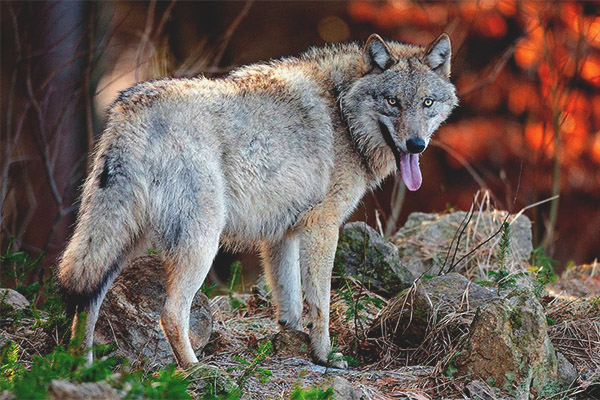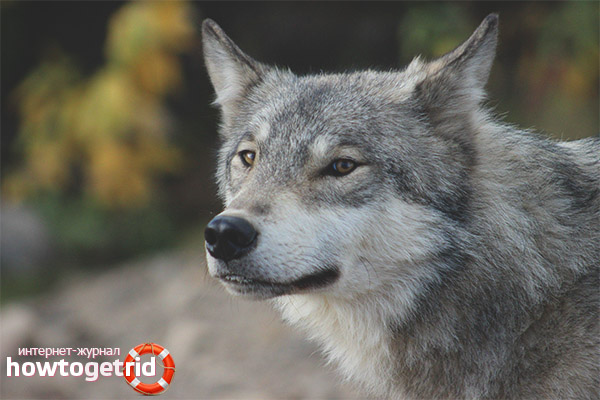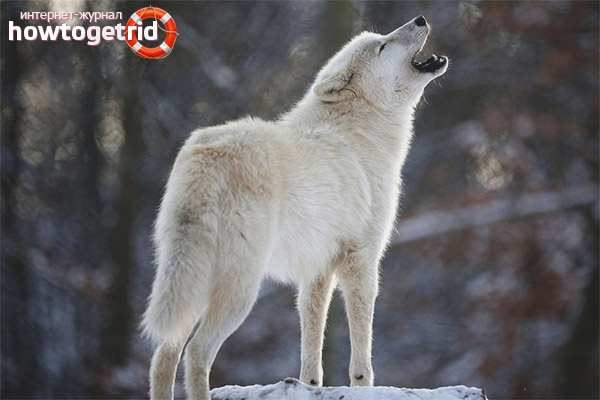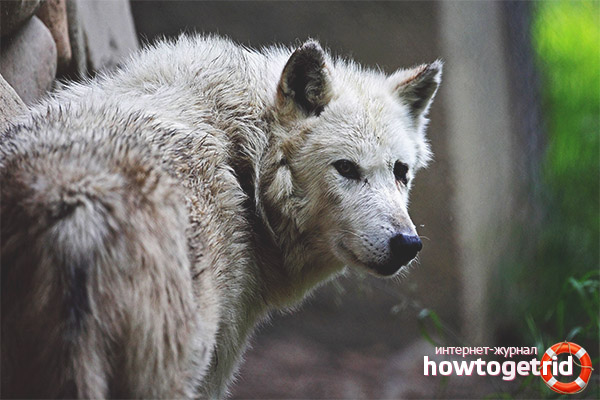The content of the article
The wolf is a typical representative of carnivorous mammals. Many are familiar with it from the literature, and some have met and live. But meeting with him does not bode well. The animal is not only widespread in nature, but also a frequent character in stories, films, both artistic and animated. It is enough, for example, to recall Jack London and his story “White Wolves”. About the cartoon "Well, wait a minute" and there is no need to say. He is familiar to all since childhood.
The name of the animal in different nations sounds differently, but is characterized by pronounced consonance. In Bulgaria, for example, this predator is called "Vylk", and in Ukraine "Vovk". In Serbian, the name sounds like “Vuk”.
general description
Most of the representatives of the wolf kingdom are of medium or large size. The largest species is considered to be related to gray and polar wolves.An adult individual at the withers can reach 85 cm. If you do not take into account the tail, the torso in length will be 1.5-1.6 meters. There is a rule that is derived by Bergman. In accordance with it, the size of the predator will be the greater, the more severe the environment in which it lives.
The mass of Siberian wolves can reach 90 kg. Such massiveness can impress anyone. The wolves of Arabia have the smallest size. For example, the mass of females rarely exceeds 10 kg. No matter which species the wolf belongs to, the female is always smaller than the male.
According to external signs, wolves have a strong resemblance to large dogs. The body is characterized by the presence of pronounced muscle relief. As for the maned wolves, they are similar in appearance to the foxes. The tail has a rather pronounced thickness and length. For wolves is characterized by massive head. The ears are sharp, set high, and the muzzle has an elongated shape. The skull of a maned wolf is similar to a fox.
In the mouth of a predator is present 42 teeth. Fangs are very large and massive. With the help of the teeth, the wolf not only tears the prey apart, but also grinds the bones. When the wolf grabs his prey, he firmly holds her fangs. Red wolves contain a dental formula in which the molars are present in a smaller amount.
The wolves, who have just come into the world, have blue eyes. After three months, an orange or golden yellow shade is already present in the iris. But the blue eyes of individual representatives remains for life.
The body of the animal is covered with thick fur. The undercoat is a two-layer character. Wool has a low thermal conductivity. This feature determines the fact that wolves are able to survive in the most severe conditions.
The color of the animal has a significant variability. In it you can find almost all shades. There are absolutely white wolves. Nature did not order so by chance. This allows wolves to perform a good disguise, merging with the surrounding landscape. Different shades indicate that each animal has its own individuality.
The predator is well developed organs of touch. Suffice it to say that he can sense the prey, which is located at a distance of 3 km from him. More than a million different shades of smell are available for his sense of smell. This circumstance renders a good service to the animal during the rut. Predator is able to mark the territory.
Simply affects the voice range of the wolf. It is difficult to say what he can not portray his voice. It is believed that wolves howl at the moon. But it is not so. With these actions, they warn their kinsmen about their location, thereby driving away aliens. But a lone wolf howls very rarely, as he is afraid to draw trouble to himself. Usually this is observed in animals in the pack.
Animals have well-developed facial expressions. Showing teeth, they thereby express their various emotions. Some elements of behavior have a certain similarity with a dog. If the animal lifts its ears and tail, it means that for some reason it is alert.
On average, a wolf can live from 8 to 16 years.If in captivity to an animal to create favorable conditions, then life can last up to 20 years.
Habitats
It so happened that the prevalence of wolves is second only to humans. They are distributed on the territory of many states, including in Russia. On the territory of our country you can find 6 species of wolves, including the red and polar wolf.
The predator has adapted to the existence of various natural areas. It can be found even in the tundra and desert. The habitat of wolves is characterized by pronounced territoriality. They are characterized by signs of social orientation. They form groups (flocks), which includes up to 40 individuals. Each flock has its own territory. Each group has its leader, or rather a pair, consisting of a male and female. There is a strict hierarchy among the pack. But during the rutting period, one can observe the disintegration of the pack, since wolves form a pair at this time.
The wolves of the burrow themselves do not dig. They prefer to occupy someone else's home, for example, a badger's hole.
Feeding wolves
A wolf is an animal that is distinguished by endurance and speed.In pursuit of prey, he, without getting tired, is able to overcome considerable distances. In the diet mainly dominated by animal food. If the prey is small in size, then hunting alone is quite possible. But to cope, for example, with a reindeer alone, a wolf cannot do it. Here, of course, need the help of the whole pack. In most cases, the wolf attacks prey if it is young or sick.
In food it uses both small animals (hare, gopher, beaver, other species), and large representatives (deer, saiga, bison). If for some reason the main food is not available, the wolf can use small amphibians (frog). In the warm season, mushrooms and berries can be present in the diet of the animal.
In some cases, the wolf can even attack a bear that is dormant or weakened by a disease or wound. In case of luck, the animal at one time can absorb up to 14 kg of meat. If a polar wolf is very hungry, he can swallow the hare entirely with bones.
Wolves have one feature. They return to the corpse of the animal in order to finish eating all that is left of it. In addition, stocks of meat for the future are made.
Steppe wolves can quench their thirst by making raids on watermelon and melon fields.
Specific types of wolves
I must say that there is a fairly large number of species of wolves. Separately, it is necessary to dwell only on some species.
- Red Wolf. It is a fairly large predator. In his appearance, in addition to the wolf's external data, the features of the jackal and the fox are reflected. The mass of an animal can reach 21 kg, and height - up to 1.1 meters. Compared with other wolves, the tail of this species is fluffy and bulky. The end of the tail is always dark in color. In the color of the red wolf red shades prevail. The species includes 10 subspecies, has the smallest number of teeth in comparison with other representatives. It has a fairly wide geographical distribution in nature, but most often it can be found in the Himalayas. Some territories are distinguished by the small number of this representative. This is due to the fact that its population has sharply decreased, in connection with which it was taken under protection.
- The wolf is maned. He is a unique representative of this family. On the nape is wool, the length of which can reach 13 cm.The presence of wool determines the formation of this mane. The weight of an animal can reach 23 kg. The length of the maned wolf can be 1.3 meters. The elongated muzzle introduces obvious imbalances in the structure of the body. Color reddish-yellow shades, but along the spine along its entire length is a dark stripe. This species lives exclusively on the flat territory. The body has extremely long limbs. In the diet uses a variety of rodents, amphibious insects, armadillos. From plants prefer to eat nightshade. In this way they get rid of nematodes.
- Eastern wolf. Until now, this species has not taken a certain place in the classification. Some consider it a hybrid of the gray wolf, while others consider it as an independent unit. With the growth of 89 cm, the weight reaches 30 kg. This applies to males. Females are somewhat more modest. In the coloring of fur there are yellowish-brown shades. On the back are dark hair. Most of them are characterized by animal food.
- Wolf ordinary (gray). It is one of the largest predators of this family. Growth of an individual reaches 86 cm. Individual specimens grow to 90 cm.Body weight is characterized by significant variability, but usually does not exceed 60 kg. The predator's tail can grow to more than half a meter. Color is characterized by variability and depends on the habitat. In the forests you can usually find representatives with a gray-brown color, and in the tundra - white wolves. But the undercoat is always gray in color. Such wolves usually use ungulates for food. This includes deer, elk, wild boar, and other representatives of the fauna. Smaller animals, like a hare, go to food. Do not mind such a wolf to eat and rodents. There are cases when gray wolves attack pets. When it comes time to harvest, predators occupy the fields on which they grow gourds. Watermelon and melon they quench their thirst. In our country, gray wolves are ubiquitous.
- Redhead look. Previously, it was considered an independent nosological unit. But with the advent of DNA analysis, it was found that such wolves are hybrids of gray wolves and coyotes. The weight of a full-grown wolf can reach 41 kg. In length, representatives of this species can grow up to 1 meter 30 centimeters.The body has a more slender character than other types of wolves. Very long legs are present. The diet consists mainly of rodents and small animals. Such wolves rarely attack large animals. A minor role in nutrition is played by mushrooms and berries. Can eat carrion. In the past century, this species was completely exterminated. Only in captivity there are 14 copies. All activities aimed at restoring the population are carried out.
- Wolf tundra. This subspecies is the least studied. In appearance there is a great similarity with the polar wolf, but representatives of this subspecies are more modest in size. Body weight can reach 49 kg. Mostly there are individuals with a gray-white color, although there are also pure white wolves. The animal has very large teeth. This subspecies is distributed almost throughout the tundra.
- Steppe wolf. Such animals are small in size. This subspecies has been little studied in comparison with other analogues. It dwells in the Kazakh steppes and in the southern territories of our country.
- Wolf Eurasian. According to external signs, it is similar to North American subspecies, but differs in more dense and short fur.A full-grown male can reach a weight of 73 kg with a growth of 76 cm. A monochromatic color is mainly characteristic and includes a wide variety of shades. In its diet uses mainly large prey and animals with medium size. Under certain circumstances, it can be used for eating small rodents.
- Wolf polar. It has a close relationship with the European wolf. The length of individual representatives can reach 1.5 meters, and the mass reaches 85 kg. The body is covered with light fur, which is quite dense in its structure. This subspecies has a good adaptation to living in extreme conditions. It is found throughout the Arctic. The duration of his life can reach 17 years.
Breeding
Puberty in animals occurs in the second year of life (female). As for the males, the ability to fertilize them appears only by 3 years. Marriage games include various courtships. This happens mutually. In the fight for a new pair of males enter the fiercest battles. For mating wolves leave the pack. The female fetus is harvested for 65 days. The number of puppies in the litter may be different, but always has an odd character.Usually the female brings 3-13 wolves. The newborn wolf cub is born completely blind. He begins to see only at the end of the second week.
Those puppies that are weaker than the others are rejected by the female herself. This is done so that the remaining young get more milk. In nutrition, puppies use the meat to burp their parents. It includes not completely digested meat. Having matured a little, wolves begin to feed on prey brought by wolves. All members of the pack take part in feeding puppies. Toward the fall, the wolf cubs are already taking part in the hunt.
Natural enemies
It is not difficult to guess that the main enemy of wolves is man. People at all times ruthlessly shot them. In addition, they are trapped everywhere. Naturally, this has a negative effect on the population.
Recently, the fashion for home wolves has gone. Dressure the wolf is served easily, but it will only execute commands if it is interesting to him.Anyone who decides to have a wolf in his house should always remember that this is an extremely unsafe event. A wolf is not a dog and must be treated with extreme caution. Especially caution must be exercised if there are children in the house.
Video: wolf (Canis lupus)














To send